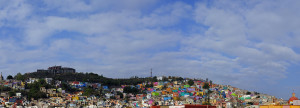GUANAJUATO — The shutters are thrown open to the sounds of the rain and the city. Thunder rolls over the hills and valleys of Guanajuato. Outside, the steep streets and narrow callejons have become rivers and waterfalls. Every day for the last three the rains have begun in the afternoon and lasted through until morning. It feels good and all too rare to leave the doors open during the night.  My bed, with its brightly colored Mexican blanket, is next to one of the small balconies and I lie awake and then sleep to the sound of falling rain and the cool, wet, unfiltered air. Across the valley, the multicolored houses are obscured by a veil of rain and in the tiny park below my balcony, under the cover of trees, a statue of Diego Rivera holds a palette with an amused look on his bronze face, seeing, I imagine, a beautiful woman in a state of dishabille. The house where the famous painter was born is just around the corner, a few doors away.
Two of my friends, Jake and Chris, both great travelers, had told me at different times of Guanajuato and how highly it ranked among the many cities’ they had visited in their peregrinations. Jake had told me of the tunnels under the city by which you arrive. I had this thought in my head during the 30-mile taxi ride from the Del BajÃo Airport in Leon to Guanajuato. As we approached the city we went through a short tunnel and I thought, well, that was nice, Jake, but not so very impressive really… And a few minutes later we entered a labyrinth of underground streets, hewn from rock, complete with intersections and signs and I mentally apologized to my friend for briefly doubting his story. We emerged from Guanajuato’s inframundo into the city center and were soon at our hotel.
 Guanajuato is built on tunnels both literally and figuratively. The tunnel system that now provides transport underneath the city’s steep, narrow streets, were originally flood tunnels that channeled away the river and kept the rains diverted from washing away the town. But Guanajuato is built on mining. It is an old city and important in the history of Mexico and Spain. The area is incredibly rich in minerals and even before the Spaniards arrived, the Aztecs were taking gold from the ground. The Spanish colonialists began mining the region in the 1540s and the city was formally established in 1548.   At one time it is estimated that 2/3 of the world’s silver supply came from the nearby La Valenciana mine alone.
Guanajuato is built on tunnels both literally and figuratively. The tunnel system that now provides transport underneath the city’s steep, narrow streets, were originally flood tunnels that channeled away the river and kept the rains diverted from washing away the town. But Guanajuato is built on mining. It is an old city and important in the history of Mexico and Spain. The area is incredibly rich in minerals and even before the Spaniards arrived, the Aztecs were taking gold from the ground. The Spanish colonialists began mining the region in the 1540s and the city was formally established in 1548.   At one time it is estimated that 2/3 of the world’s silver supply came from the nearby La Valenciana mine alone.
As we entered the old city proper my wife said that it reminded her very much of Tallinn, Estonia. My thought was Budapest, Hungary and those first impressions lingered over the course of the coming week. It was certainly seen in the old European feel of many of the buildings and in the beautiful, tree-shaded public squares surrounded by cafés and restaurants. The old city was, after all, built by Spaniards and during the Porfiriato, the 34-year period between 1876 and 1911 during the Presidency of Porfirio Diaz, European (specifically Parisian) architecture was the order of the day. France has had a long history with Mexico and during the Diaz administration French culture and architecture became inextricably entwined with Mexico. There are neighborhoods in Mexico City that feel almost identical to areas of Paris and that fashion extended across the country. But I believe it was not just the fin de siècle buildings that reminded us of cities like Tallinn and Budapest. There is no question that Guanajuato is a Mexican city, an old, proud place with history and traditions vital to the narrative of the Mexican Republic.
The city of Guanajuato is also the capital of the Free and Sovereign State of Guanajuato (Estado Libre y Soberano de Guanajuato). In this region are numerous other sites of great importance to the history of Mexico.   The region has attracted large numbers of both tourists and retirees, drawn by the good climate and gracious pace of life. Perhaps most famous of the cities that have attracted these snow-fleeing gringos in their golden years is San Miguel de Allende. San Miguel de Allende is about 60 miles from Guanajuato and we hired a car to take us there for the afternoon. I know San Miguel has many fans and it is, without a doubt, a lovely small city with its central park and cathedral perched atop a hill. But, from the first moment there, I felt that the psychological balance of the city had shifted to the arrivistes. The cafés were full of loud, ill-mannered Europeans, aging Americans, and their little dogs too. The locals serving them did so in the perfunctory and not-quite-friendly manner of people whose lives had been taken over by outsiders. San Miguel is a lovely town but has become that type of place where neo-colonial outsiders dictate the pace and the locals find themselves under occupation by leathery retirees and wealthy young hippies lacking the courage to seek dissipation in more hazardous locations. It is the type of place where the sun is bright and hot during the day, the nights are cool, and no one judges your drinking habits too harshly. I will not be disappointed if I never return.
 Guanajuato has many visitors but is still firmly in the possession of the people who grew up there. The city still has its secrets and the citizens are friendly and gracious because you are on their ground and they need not feel like visitors in their own town. I think it was this, more than anything, that reminded us of those two European cities, Tallinn and Budapest. I remember once, in Budapest, I walked into a café-lined square.  It was a beautiful, late-summer day, and in the square was an art nouveau bar made of hand-hammered copper. People were standing around the bar drinking cocktails and laughing and I do not think one of them was a tourist. They were doing so because it was a lovely day and the Hungarians deeply love their city, their language and food and culture. The center of Tallinn is one of the most perfectly preserved medieval cities. It is so well kept that it appears almost like a set, but it is not. In both Budapest and Tallinn, like Guanajuato, there are plenty of tourists but the locals love their grand old cities and enjoy their parks and squares and traditions and feel still that their cities belong to them. Guanajuato still has and keeps its secrets.
Guanajuato has many visitors but is still firmly in the possession of the people who grew up there. The city still has its secrets and the citizens are friendly and gracious because you are on their ground and they need not feel like visitors in their own town. I think it was this, more than anything, that reminded us of those two European cities, Tallinn and Budapest. I remember once, in Budapest, I walked into a café-lined square.  It was a beautiful, late-summer day, and in the square was an art nouveau bar made of hand-hammered copper. People were standing around the bar drinking cocktails and laughing and I do not think one of them was a tourist. They were doing so because it was a lovely day and the Hungarians deeply love their city, their language and food and culture. The center of Tallinn is one of the most perfectly preserved medieval cities. It is so well kept that it appears almost like a set, but it is not. In both Budapest and Tallinn, like Guanajuato, there are plenty of tourists but the locals love their grand old cities and enjoy their parks and squares and traditions and feel still that their cities belong to them. Guanajuato still has and keeps its secrets.
There are many specific places to see in Guanajuato, among them the famous Mummy Museum, the Bocamina and other mines, the Diego Rivera Museum and Home, the Alley of the Kiss, and Mercado Hidalgo, but the main attraction is really to explore the old streets, to sit in the cafés and listen to music performed in the parks, to see Mexico at its most lovely and gracious.  There are many places in the world to visit, too many I wish to see. But there are places I want very much to return to. I feel sad at the thought of never again seeing Paris, or Tallinn, or Budapest and now, Guanajuato.

Post a Comment